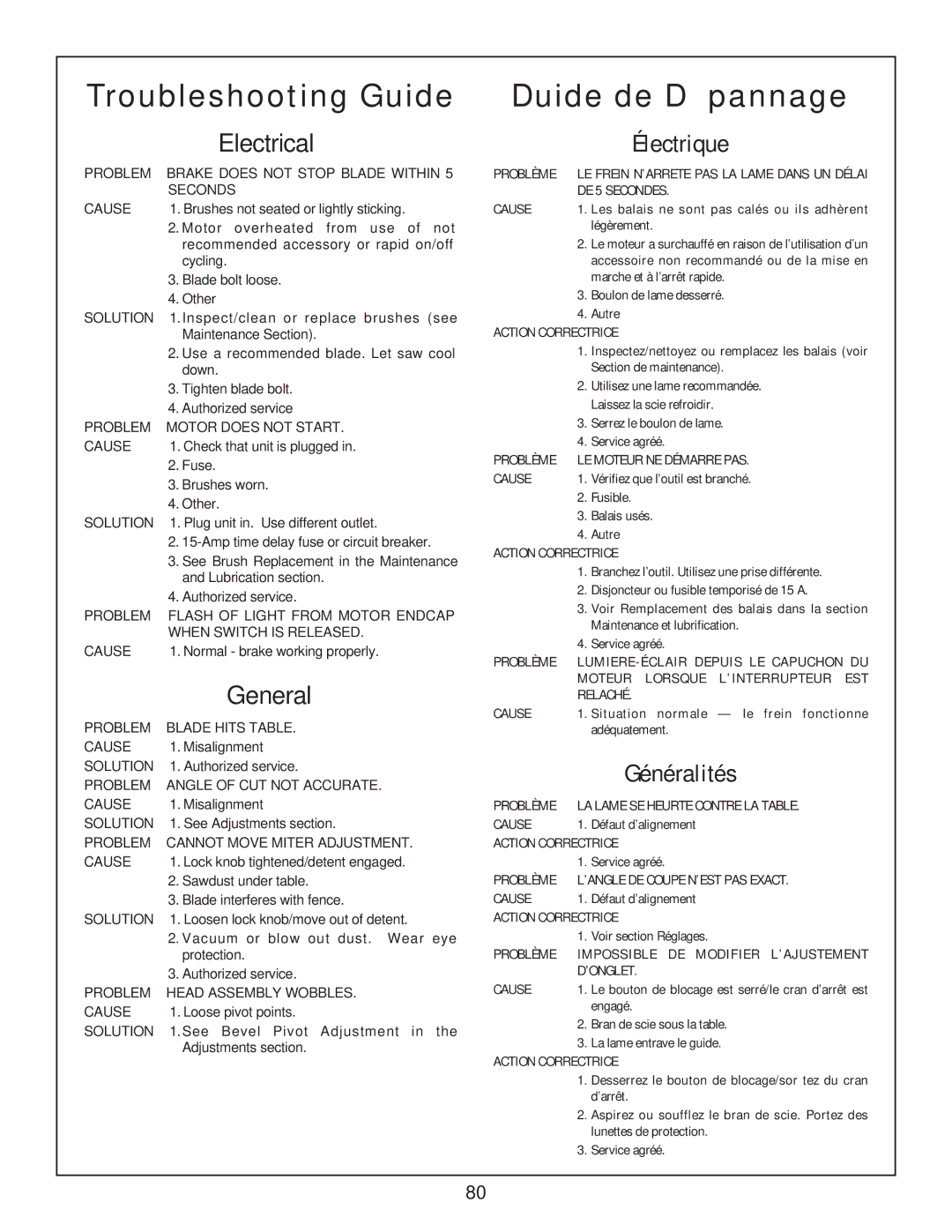
Troubleshooting Guide
| Electrical |
PROBLEM | BRAKE DOES NOT STOP BLADE WITHIN 5 |
| SECONDS |
CAUSE | 1. Brushes not seated or lightly sticking. |
| 2. Motor overheated from use of not |
| recommended accessory or rapid on/off |
| cycling. |
| 3. Blade bolt loose. |
| 4. Other |
SOLUTION | 1. Inspect/clean or replace brushes (see |
| Maintenance Section). |
| 2. Use a recommended blade. Let saw cool |
| down. |
| 3. Tighten blade bolt. |
| 4. Authorized service |
PROBLEM | MOTOR DOES NOT START. |
CAUSE | 1. Check that unit is plugged in. |
| 2. Fuse. |
| 3. Brushes worn. |
| 4. Other. |
SOLUTION | 1. Plug unit in. Use different outlet. |
| 2. |
| 3. See Brush Replacement in the Maintenance |
| and Lubrication section. |
| 4. Authorized service. |
PROBLEM | FLASH OF LIGHT FROM MOTOR ENDCAP |
| WHEN SWITCH IS RELEASED. |
CAUSE | 1. Normal - brake working properly. |
| General |
PROBLEM | BLADE HITS TABLE. |
CAUSE | 1. Misalignment |
SOLUTION | 1. Authorized service. |
PROBLEM | ANGLE OF CUT NOT ACCURATE. |
CAUSE | 1. Misalignment |
SOLUTION | 1. See Adjustments section. |
PROBLEM | CANNOT MOVE MITER ADJUSTMENT. |
CAUSE | 1. Lock knob tightened/detent engaged. |
| 2. Sawdust under table. |
| 3. Blade interferes with fence. |
SOLUTION | 1. Loosen lock knob/move out of detent. |
| 2. Vacuum or blow out dust. Wear eye |
| protection. |
| 3. Authorized service. |
PROBLEM | HEAD ASSEMBLY WOBBLES. |
CAUSE | 1. Loose pivot points. |
SOLUTION | 1. See Bevel Pivot Adjustment in the |
| Adjustments section. |
Duide de Dépannage
|
| Électrique |
PROBLÈME | LE FREIN N’ARRETE PAS LA LAME DANS UN DÉLAI | |
| DE 5 SECONDES. | |
CAUSE | 1. | Les balais ne sont pas calés ou ils adhèrent |
|
| légèrement. |
| 2. | Le moteur a surchauffé en raison de l’utilisation d’un |
|
| accessoire non recommandé ou de la mise en |
|
| marche et à l’arrêt rapide. |
| 3. | Boulon de lame desserré. |
| 4. | Autre |
ACTION CORRECTRICE
| 1. | Inspectez/nettoyez ou remplacez les balais (voir |
|
| Section de maintenance). |
| 2. | Utilisez une lame recommandée. |
|
| Laissez la scie refroidir. |
| 3. | Serrez le boulon de lame. |
| 4. | Service agréé. |
PROBLÈME | LE MOTEUR NE DÉMARRE PAS. | |
CAUSE | 1. Vérifiez que l’outil est branché. | |
2.Fusible.
3.Balais usés.
4.Autre
ACTION CORRECTRICE
1.Branchez l’outil. Utilisez une prise différente.
2.Disjoncteur ou fusible temporisé de 15 A.
3.Voir Remplacement des balais dans la section Maintenance et lubrification.
4.Service agréé.
PROBLÈME | |
| MOTEUR LORSQUE L’INTERRUPTEUR EST |
| RELACHÉ. |
CAUSE | 1. Situation normale — le frein fonctionne |
| adéquatement. |
|
| Généralités |
PROBLÈME | LA LAME SE HEURTE CONTRE LA TABLE. | |
CAUSE | 1. | Défaut d’alignement |
ACTION CORRECTRICE | ||
| 1. | Service agréé. |
PROBLÈME | L’ANGLE DE COUPE N’EST PAS EXACT. | |
CAUSE | 1. | Défaut d’alignement |
ACTION CORRECTRICE | ||
| 1. | Voir section Réglages. |
PROBLÈME | IMPOSSIBLE DE MODIFIER L’AJUSTEMENT | |
| D’ONGLET. | |
CAUSE | 1. | Le bouton de blocage est serré/le cran d’arrêt est |
|
| engagé. |
2.Bran de scie sous la table.
3.La lame entrave le guide.
ACTION CORRECTRICE
1.Desserrez le bouton de blocage/sor tez du cran d’arrêt.
2.Aspirez ou soufflez le bran de scie. Portez des lunettes de protection.
3.Service agréé.
80
